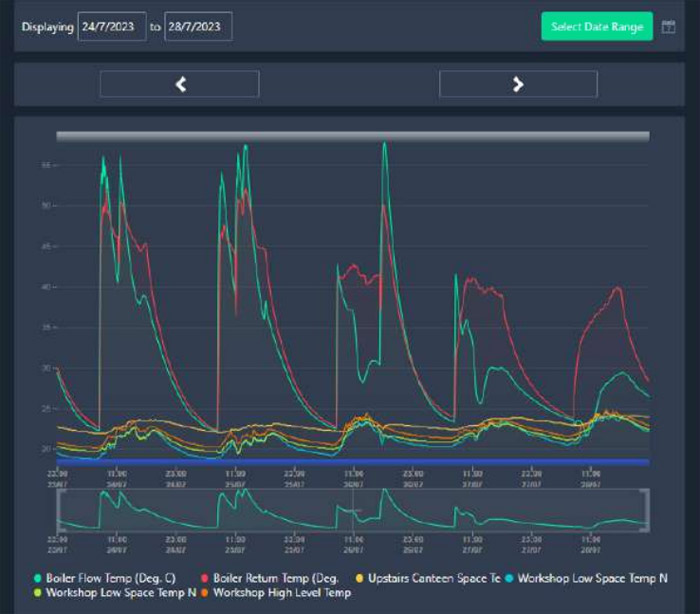BMS and Asset Integration
(article published in the Energy Managers Association magazine)
SYSTEM IN PLACE:
The site is a large retail outlet where the BMS system has been integrated with Heat pumps, Air Conditioning (AC) and Variable Refrigerant Volume (VRV) units, Packaged AHU, lighting controls, PV systems and smart meter networks. Integration includes both Modbus and BACnet communications.
The sitewide communication – multiple control panels – is via the customer’s internal IP network in collaboration with the customer’s IT department. The site is 5 years old and has a monthly maintenance regime in place. The site has remote connectivity with full proactive monitoring via a remote service package.
CURRENT CONTROLS & OPTIMISATION:
The BMS has been engineered to control and monitor the site’s HVAC assets and plant – the main focus is on the design to provide the below benefits.
1. Improve and then maintain the site’s energy performance and carbon emissions.
2. Ensure staff and visitor health, wellbeing and comfort at all times.
3. Improve maintenance efficiencies – both labour and costs, to reduce reactive call outs and negate the need for manual interventions by site staff.
4. Provide online and site dashboards to inform the owners and the occupants on how the building is performing from both an energy and environmental aspect.
5. Critical alarms proactively report via the online portal, email and GSM – to ensure issues are dealt with immediately (to meet agreed KPIs) to reduce impact on the site’s environment and energy performance. Proactive alarms report directly to the portal as well as the customer’s engineering helpdesk and out of hours call out engineers’ mobiles.
6. The network of smart meters report proactively with alarms should any areas and/or assets exceed agreed energy thresholds set up – including PV generation plants.
7. The customer and its approved supply chain has full access to the online portal and monitoring dashboards.

LESSONS LEARNT FROM OPERATING THE SYSTEM:
BMS systems are intended to control and monitor a site fully to ensure maximum energy performance is as designed, to ensure best environmental conditions within, and to keep wastage (cost and consumption) costs to a minimum.
To receive the maximum benefits from a BMS design – the system should control and monitor all aspects and assets associated with how the building operates – this includes heating, ventilation, air conditioning, lighting, renewables, on site generation, utilities and environmental monitoring (including air quality). Aligned to this can be added more Facilities Management assets such as fire, security and compliance monitoring (emergency lighting and legionella checks, etc).
Sadly – mainly due to designs, specifications and costs – BMS systems mainly consist of HVAC only.
The main cause of reduced specifications and designs is the fact most BMS systems are installed on a return-on-investment business case. This is where the problem is – how the business case is created and what features and benefits are being sold. In the main, the business case is reporting on savings to be made from energy reduction only. However, in principle, a BMS business case now covers many aspects for improving a customer’s bottom line profit. In addition to reduction in energy costs, the below viable cost saving should also be factored into the business case:
- Improvement
in maintenance
efficiencies. - Improved life
cycle costs. - Improved staff comfort and
wellbeing (less absences and
improved staff performance). - Improved energy procurement
and reduced fixed charges. - Assistance with legislation and
compliance mandates
Originally, the site being discussed didn’t have full integration but had systems in a ‘silo’ set up – controlled independently of each other. This had a negative effect on the building’s systems and performance as it negated the opportunity for a more demand led control strategy being implemented. Since full integration was implemented, we can now control the heating, ventilation and air-conditioning all in tandem with each other rather than as it was before, fighting against each other. For example, we now have ‘dead-band’ control where heating can’t be used when cooling is enabled and we can now ensure we use the free heating/cooling available from the external ambient conditions. The system also didn’t have proactive alarm reporting and all alarms were reporting to a desk top located in the plant room – which wasn’t accessed easily or regularly, and meant issues went unnoticed for long periods between site maintenance visits. The results now show a reduction in call outs, plant failure down time and improved internal environmental conditions for the staff.
Before remote connectivity and monitoring was instigated, the customer was experiencing a lot of ‘unnecessary’ call outs for non-critical and/or simple system changes (set point adjustments, etc). This became expensive and increased the embedded carbon emissions associated with call out travelling. The remote monitoring reduced both with immediate effect.

FUTURE UPGRADES:
Now the site has been reengineered as detailed – all with the aim of improving the energy performance and
maintenance efficiencies – savings of over 20% are being realised and maintained. The savings are now being
reinvested – ‘save to invest to save’ approach – to allow for more energy efficiency measures to be implemented – business cases now being discussed for below projects:
- Heat recovery systems.
- Utility (gas and water) monitoring.
- Additional monitoring.


